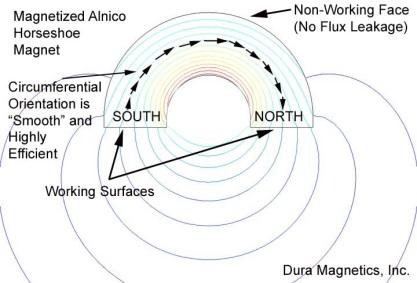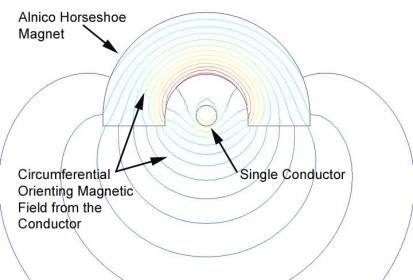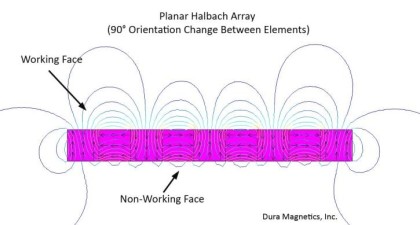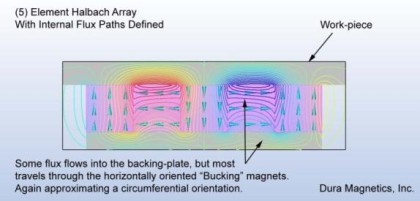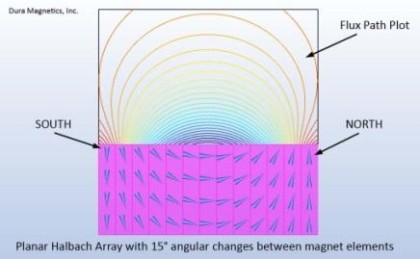In our previous TechTalk article about Halbach Arrays, we discussed what a Halbach Array might be composed of, and why these arrays are useful. But how do these arrays create a magnetic field, and how are these fields used?
In this second installment of our four-part series explaining Halbach Arrays, we will look at the field geometries of the two most common Halbach Array orientations and debunk a few common misconceptions about how these magnetic fields are used and function.
Ideal Geometries for Halbach Arrays
An array that employs magnetic elements and whose magnetic orientation seems to be angularly iterative, rotating from element to element, is approximating the ideal circumferential orientation of a common horseshoe magnet. An otherwise unassuming Alnico horseshoe magnet has a near-ideal geometry and magnetic orientation.
Magnet Orientation in Circumferential Arrays
The detailed orientation of anisotropic Alnico magnets is beyond the scope of this series, but in simple terms:
An Alnico horseshoe magnet is oriented in a field produced by a single conductor running through the horseshoe’s legs.
Halbach Array Flux Diagrams
This single conductor’s magnetic field is circumferential, and this imparts a circumferential orientation into the horseshoe magnet. This means that the entire effective “length” of the horseshoe contributes to the net “working” magnetic field, and there is very little flux leakage along the length.
This is very similar to:
- a Planar Halbach Array where most of the magnetic field is biased to one side of the array
- a Halbach Cylinder, where most of the magnetic field is concentrated on the ID
Circular Halbach Arrays and Halbach Cylinders
One of the most desirable magnetic field geometries in charged particle applications is a field that is very uniform (homogenous) and very strong (high density).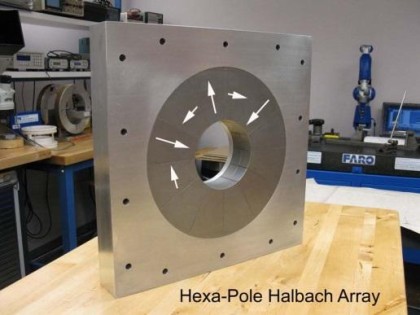
How do Halbach Cylinder Arrangements work?
Dr. Halbach developed ring arrangements of magnets, called Halbach Cylinders, which creates high density and high uniformity in the Inside Diameter of the structure. The simplest geometry is an arrangement of wedge shaped magnets with various magnetic orientations around a common axis. We would call this a Circular Halbach Array / Halbach Cylinder. Here, the internal poles are not limited to one North and one South.
By adding iterations of the magnet wedges, one can create a quadra-pole, hexa-pole, etc.
Circular Halbach Arrays are not limited to the usable field existing in the Inside Diameter. The reverse of the Classical Halbach Cylinder can be used to create the working field on Outside Diameter (OD).
Having the strong field on the OD is very beneficial for all types of rotating electro-mechanical applications. They can be used in rotors for:
- brushless DC motors
- magnetic couplers
- power generation
How do Planar Halbach Arrays work?
One can also produce a Planar Halbach Array. A planar Halbach Array can be thought of as an unrolled circular array. This variation does not necessarily create a uniform field, but it does create a very strong magnetic field on one working-face. This is useful for applications involving:
- holding
- fixturing
- linear coupling
Planar Halbach Arrays can be used together to create a dipole-like structure where the NORTH – SOUTH poles alternate, while moving into the gap. This magnet arrangement is used in “Wigglers” which create directional changes in an accelerated particle. This wiggling particle will then emit a tunable electromagnetic radiation ranging from Radio Frequencies to Ultraviolet Light.
Common Misconceptions About Halbach Array Magnetic Fields
Contrary to many Internet sources, the magnetic field on the non-working side of a Halbach Array (Planer or Cylindrical) DOES NOT CANCEL.
The magnetic flux does not emanate from the non-working surfaces, because it is contained within the magnetic circuit.
It does not cancel, nor is it “insulated”; it prefers to stay within the magnetic alloy.
Again, this is similar to the circumferential orientation, but unlike an Alnico magnet, magnet alloys used in Halbach Arrays cannot be oriented circumferentially, and thus, the circuit must be pieced together with individual magnets.
As stated above, most published Halbach Arrays use a 90° orientation change between magnets. This is a coarse approximation to the smooth, sweeping circumferential orientation. Thus, the smaller the angular difference between the magnets in an array and the greater number of elements, the greater the efficiency of the magnetic circuit.
With the knowledge of these dominant iterations and applications, we can better appreciate the role Halbach Arrays play in common uses. Our upcoming third article of this four-part series on Halbach Arrays will cover design elements of Halbach Arrays, including variables that impact how each array is assembled, and alternate designs.


